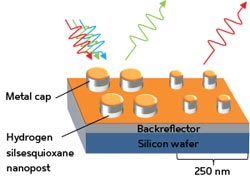Nanotechnology: Color printing reaches new highs

Variation in post size and spacing in the metal array alters which incoming wavelength of light (red, green or blue) is reflected back.<br><br>Reproduced from Ref. 1 © 2012 K. Kumar et al.<br>
Commercial laser printers typically produce pin-sharp images with spots of ink about 20 micrometers apart, resulting in a resolution of 1,200 dots per inch (dpi). By shrinking the separation to just 250 nanometers — roughly 100 times smaller — a research team at A*STAR can now print images at an incredible 100,000 dpi, the highest possible resolution for a color image1. These images could be used as minuscule anti-counterfeit tags or to encode high-density data.
To print the image, the team coated a silicon wafer with insulating hydrogen silsesquioxane and then removed part of that layer to leave behind a series of upright posts of about 95 nanometers high. They capped these nanoposts with layers of chromium, silver and gold (1, 15 and 5 nanometers thick, respectively), and also coated the wafer with metal to act as a backreflector.
Each color pixel in the image contained four posts at most, arranged in a square. The researchers were able to produce a rainbow of colors simply by varying the spacing and diameter of the posts to between 50 nanometers and 140 nanometers.
When light hits the thin metal layer that caps the posts, it sends ripples — known as plasmons — running through the electrons in the metal. The size of the post determines which wavelengths of light are absorbed, and which are reflected (see image).
The plasmons in the metal caps also cause electrons in the backreflector to oscillate. “This coupling channels energy from the disks into the backreflector plane, thus creating strong absorption that results in certain colors being subtracted from the visible spectrum,” says Joel Yang, who led the team of researchers at the A*STAR Institute of Materials Research and Engineering and the A*STAR Institute of High Performance Computing.
Printing images in this way makes them potentially more durable than those created with conventional dyes. In addition, color images cannot be any more detailed: two adjacent dots blur into one if they are closer than half the wavelength of the light reflecting from them. Since the wavelength of visible light ranges about 380–780 nanometers, the nanoposts are as close as is physically possible to produce a reasonable range of colors.
Although the process takes several hours, Yang suggests that a template for the nanoposts could rapidly stamp many copies of the image. “We are also exploring novel methods to control the polarization of light with these nanostructures and approaches to improve the color purity of the pixels,” he adds.
The A*STAR-affiliated researchers contributing to this research are from the A*STAR Institute of Materials Research and Engineering and the A*STAR Institute of High Performance Computing
Journal information
Kumar, K., Duan, H., Hegde, R. S., Koh, S. C. W., Wei, J. N. & Yang, J. K. W. Printing colour at the optical diffraction limit. Nature Nanotechnology 7, 557–561 (2012).
Media Contact
All latest news from the category: Materials Sciences
Materials management deals with the research, development, manufacturing and processing of raw and industrial materials. Key aspects here are biological and medical issues, which play an increasingly important role in this field.
innovations-report offers in-depth articles related to the development and application of materials and the structure and properties of new materials.
Newest articles

Sea slugs inspire highly stretchable biomedical sensor
USC Viterbi School of Engineering researcher Hangbo Zhao presents findings on highly stretchable and customizable microneedles for application in fields including neuroscience, tissue engineering, and wearable bioelectronics. The revolution in…

Twisting and binding matter waves with photons in a cavity
Precisely measuring the energy states of individual atoms has been a historical challenge for physicists due to atomic recoil. When an atom interacts with a photon, the atom “recoils” in…

Nanotubes, nanoparticles, and antibodies detect tiny amounts of fentanyl
New sensor is six orders of magnitude more sensitive than the next best thing. A research team at Pitt led by Alexander Star, a chemistry professor in the Kenneth P. Dietrich…





















